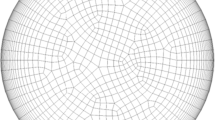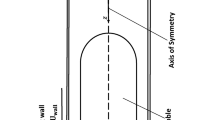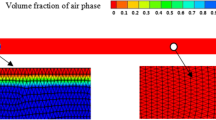Abstract
This numerical study investigates the dynamics around a single Taylor bubble rising with small-dispersed bubbles in a vertical pipeline. The Volume-of-fluid (VOF) method in Ansys Fluent 18.1 is used to track the Taylor bubble, and the Discrete Particle Method (DPM) is used to track the small-dispersed bubbles, for the following parameter range; \(812 \leqslant \text{Re} \leqslant 5684\), \({\kern 1pt} Eo = 94\) and \(\log (Mo) = - 10.6\). The coupling strategies for both the continuous gas–liquid phase as well as the discrete bubble phase are all accounted for in the numerical calculations. The dispersed bubbles significantly affect the behaviour of the rising Taylor bubble in numerous ways. The terminal velocity increases with an increase in the number of dispersed bubbles. The rise velocity is, however directly correlated with the deformation of the nose of the bubble. The flow dynamics around the nose of the Taylor bubble are stronger for low velocities due to lower inertia. The computations also demonstrated that there are both acceleration and deceleration effects on the Taylor bubble. Our predictions are in quantitative agreement with published experimental results by Cerqueira and Paladino (Int. J. Multiph. Flow, vol. 133, p. 103,450, Dec. 2020).












Similar content being viewed by others
Abbreviations
- A :
-
The exposed front area of the bubble moving relative to the liquid
- C D :
-
Drag coefficient
- C L :
-
Lift force coefficient
- D :
-
Diameter of the pipe, m
- D b :
-
Diameter of the bubble
- D h :
-
The maximum horizontal dimension of the bubble
- DPM:
-
Discrete particle method
- Eo :
-
Eotvos number
- f :
-
Fluid
- F b :
-
The total force acting on the bubble
- F B :
-
Buoyancy force
- F D :
-
Drag force
- F DC :
-
The volumetric force from the discrete small bubbles phase to continuous fluid phase
- F L :
-
Lift force
- F r :
-
Froude number
- F ST :
-
Stands for the volumetric force for surface tension
- F VM :
-
Mass force
- G :
-
Gas phase
- GCI:
-
Grid convergence index
- g :
-
Acceleration due to gravity, m/s2
- K:
-
Inter-phase momentum exchange coefficient
- L :
-
Liquid phase
- L s :
-
Liquid slug length
- m b :
-
Mass of the bubble
- Mo :
-
Morton number
- MFR:
-
Moving frame of reference
- N f :
-
Inverse viscosity number
- R :
-
Bubble radius, m
- Re:
-
Reynold’s number
- u b :
-
Bubble velocity
- u Slip :
-
Slip velocity (or relative velocity) between the two phases
- U TB :
-
Taylor bubble velocity, m/s
- U inlet :
-
Inlet velocity, m/s
- U oulet :
-
Outlet velocity, m/s
- U wall :
-
Wall velocity, m/s
- U 0 :
-
Taylor bubble drift velocity, m/s
- \(U_{TB}^{\prime}\) :
-
Rise velocity of trailing Taylor bubble, m/s
- U m :
-
Mixture velocity, m/s
- VOF:
-
Volume of fluid method
- V cell :
-
Volume of cell
- V b :
-
Bubble volume
- ρ*:
-
Density ratio
- μ*:
-
Viscosity ratio
- k :
-
The kth phase fluid
- κ :
-
Interface curvature
- σ :
-
Surface tension, N/m
- ρ G :
-
Gas density, kg/m3
- ρ L :
-
Liquid density, kg/m3
- μ e :
-
Effective viscosity
- μ G :
-
Gas viscosity, kg/m
- μ L :
-
Liquid viscosity, kg/m
- α b :
-
The volume fraction of the small dispersed bubble
- α G :
-
The volume fraction of the gas phase
- δ LF :
-
Liquid film thickness
- Φ:
-
Volume colour function
- av:
-
Average value for a unit cell
- b:
-
Bubble
- f:
-
Fluid
- G:
-
Gas
- I:
-
Interface
- In:
-
Inlet
- L:
-
Liquid
- Out:
-
Outlet
- TB:
-
Taylor bubble
- TP:
-
Two-phase flow
References
Morgado AO, Miranda JM, Araújo JDP, Campos JBLM (2016) Review on vertical gas–liquid slug flow. Int J Multiph Flow 85:348–368
Gawusu S, Zhang X (2021) Hydrodynamics analysis of Taylor flow in oil and gas pipelines under constant heat flux. Heat Mass Transf 57(3):515–527
Elvira KS, Solvas XC, Wootton RCR, DeMello AJ (2013) The past, present and potential for microfluidic reactor technology in chemical synthesis. Nat Chem 5(11):905–915
Liu Q, Luo Z-H (2018) CFD-VOF-DPM simulations of bubble rising and coalescence in low hold-up particle-liquid suspension systems. Powder Technol 339:459–469
Zhang J, Li S, Wang X, Sundén B, Wu Z (2020) Numerical studies of gas-liquid Taylor flows in vertical capillaries using CuO/water nanofluids. Int Commun Heat Mass Transf 116:104665
Batchvarov A, Kahouadji L, Magnini M, Constante-Amores CR, Shin S, Chergui J, Juric D, Craster RV, Matar OK (2020) Effect of surfactant on elongated bubbles in capillary tubes at high Reynolds number. Phys Rev Fluids 5(9):93605
Nešić S (2007) Key issues related to modelling of internal corrosion of oil and gas pipelines—a review. Corros Sci 49(12):4308–4338
Yan K, Che D (2011) Hydrodynamic and mass transfer characteristics of slug flow in a vertical pipe with and without dispersed small bubbles. Int J Multiph Flow 37(4):299–325
Zheng D, He X, Che D (2007) CFD simulations of hydrodynamic characteristics in a gas–liquid vertical upward slug flow. Int J Heat Mass Transf 50(21–22):4151–4165
Zhang T, Ma L, Zhang J (2021) Numerical investigation on the longitudinal distribution characteristics of falling film flow outside a vertical tube. Heat Mass Transf. https://doi.org/10.1007/s00231-021-03056-3
Cerqueira RFL, Paladino EE (2020) Experimental study of the flow structure around Taylor bubbles in the presence of dispersed bubbles. Int J Multiph Flow 133:103450
Hayashi K, Hosoda S, Tryggvason G, Tomiyama A (2014) Effects of shape oscillation on mass transfer from a Taylor bubble. Int J Multiph Flow 58:236–245
Leung SSY, Gupta R, Fletcher DF, Haynes BS (2012) Effect of flow characteristics on Taylor flow heat transfer. Ind Eng Chem Res 51(4):2010–2020
Asadolahi AN, Gupta R, Fletcher DF, Haynes BS (2011) CFD approaches for the simulation of hydrodynamics and heat transfer in Taylor flow. Chem Eng Sci 66(22):5575–5584
Gupta R, Fletcher DF, Haynes BS (2010) CFD modelling of flow and heat transfer in the Taylor flow regime. Chem Eng Sci 65(6):2094–2107
Walsh PA, Walsh EJ, Muzychka YS (2010) Heat transfer model for gas–liquid slug flows under constant flux. Int J Heat Mass Transf 53(15–16):3193–3201
Bento D, Rodrigues R, Faustino V, Pinho D, Fernandes C, Pereira A, Garcia V, Miranda J, Lima R (2018) Deformation of red blood cells, air bubbles, and droplets in microfluidic devices: flow visualizations and measurements. Micromachines 9(4):151
Nogueira S, Riethmuler ML, Campos JBLM, Pinto AMFR (2006) Flow in the nose region and annular film around a Taylor bubble rising through vertical columns of stagnant and flowing Newtonian liquids. Chem Eng Sci 61(2):845–857
Nogueira S, Sousa RG, Pinto AMFRFR, Riethmuller ML, Campos JBLMLM (2003) Simultaneous PIV and pulsed shadow technique in slug flow: a solution for optical problems. Exp Fluids 35(6):598–609
Heiszwolf JJ, Kreutzer MT, van den Eijnden MG, Kapteijn F, Moulijn JA (2001) Gas–liquid mass transfer of aqueous Taylor flow in monoliths. Catal Today 69(1–4):51–55
Fershtman A, Babin V, Barnea D, Shemer L (2017) On shapes and motion of an elongated bubble in downward liquid pipe flow. Phys Fluids 29(11):112103
Bento D, Lopes S, Maia I, Lima R, Miranda JM (2020) Bubbles moving in blood flow in a microchannel network: the effect on the local hematocrit. Micromachines 11(4):344
Pinto AMFR, Coelho Pinheiro MN, Nogueira S, Ferreira VD, Campos JBLM (2005) Experimental study on the transition in the velocity of individual Taylor bubbles in vertical upward co-current liquid flow. Chem Eng Res Des 83(9):1103–1110
Direito F, Campos J, Miranda J (2017) Interaction between two consecutive axisymmetric Taylor drops flowing in a heavier liquid in a vertical tube. Int J Heat Fluid Flow 68:1–12
Araújo JDPDP, Miranda JMM, Campos JBLMBLM (2013) Simulation of slug flow systems under laminar regime: Hydrodynamics with individual and a pair of consecutive Taylor bubbles. J Pet Sci Eng 111:1–14
Azevedo MB, de; Santos, D. dos; Faccini, J.L.H., Su, J. (2017) Experimental study of the falling film of liquid around a Taylor bubble. Int J Multiph Flow 88:133–141
Santos LMTMT, Coelho Pinheiro MNN (2014) Flow around individual Taylor bubbles rising in a vertical column with water: effect of gas expansion. Int J Multiph Flow 63:39–51
Sousa RG, Pinto AMFR, Campos JBLM (2006) Effect of gas expansion on the velocity of a Taylor bubble: PIV measurements. Int J Multiph Flow 32(10–11):1182–1190
Sousa RG, Riethmuller ML, Pinto AMFR, Campos JBLM (2006) Flow around individual Taylor bubbles rising in stagnant polyacrylamide (PAA) solutions. J Nonnewton Fluid Mech 135(1):16–31
Roshdi S, Kasiri N (2021) Coupling VOF interfacial mass transfer model with RSM approach in LLE systems: developing the new correlations for mass transfer, aspect ratio and terminal velocity. Int Commun Heat Mass Transf 123:10526
Hua J (2015) CFD simulations of the effects of small dispersed bubbles on the rising of a single large bubble in 2D vertical channels. Chem Eng Sci 123:99–115
Li Y, Zhang J, Fan L-S (1999) Numerical simulation of gas–liquid–solid fluidization systems using a combined CFD-VOF-DPM method: bubble wake behavior. Chem Eng Sci 54(21):5101–5107
Tomar G, Fuster D, Zaleski S, Popinet S (2010) Multiscale simulations of primary atomization. Comput Fluids 39(10):1864–1874
Celis GEO, Rosero CMP, Loureiro JBR, Silva Freire AP (2021) Breakup and coalescence of large and small bubbles in sudden expansions and contractions in vertical pipes. Int J Multiph Flow 137:103548
Direito FJN, Campos JBLM, Miranda JM (2016) Rising of a single Taylor drop in a stagnant liquid—2D laminar flow and axisymmetry limits. Phys Fluids 28(5):57101
Wang C, Tian M, Zhang J, Zhang G, Zhang Y (2020) Numerical study on pressure drop and heat transfer characteristics of gas-liquid Taylor flow in a microchannel based on FFR method. Int Commun Heat Mass Transf 117:104802
Shemer L, Gulitski A, Barnea D (2005) Experiments on the turbulent structure and the void fraction distribution in the Taylor bubble wake. Multiph Sci Technol 17(1–2):103–122
Massoud EZZ, Xiao Q, El-gamal HAA, Teamah MAA (2018) Numerical study of an individual Taylor bubble rising through stagnant liquids under laminar flow regime. Ocean Eng 162(March):117–137
Massoud EZ, Xiao Q, El-gamal HA (2019) Numerical study of an individual Taylor bubble drifting through stagnant liquid in an inclined pipe. Ocean Eng 195:106648
Kumari S, Kumar N, Gupta R (2019) Flow and heat transfer in slug flow in microchannels: effect of bubble volume. Int J Heat Mass Transf 129:812–826
Frederix EMA, Komen EMJ, Tiselj I, Mikuž B (2020) LES of turbulent co-current taylor bubble flow. Flow Turbul Combust 105(2):471–495
Oishi Y, Murai Y (2014) Horizontal turbulent channel flow interacted by a single large bubble. Exp Therm Fluid Sci 55:128–139
Jia HW, Zhang P (2016) Investigation of the Taylor bubble under the effect of dissolution in microchannel. Chem Eng J 285:252–263
Dang M, Yue J, Chen G (2015) Numerical simulation of Taylor bubble formation in a microchannel with a converging shape mixing junction. Chem Eng J 262:616–627
Ge L, Peng Z, Moreno-Atanasio R, Doroodchi E, Evans GM (2020) Three-dimensional VOF-DEM model for simulating particle dynamics in the liquid slugs of a vertical gas–liquid–solid Taylor flow microreactor. Ind Eng Chem Res 59(16):7965–7981
Li Y, Hosseini M, Arasteh H, Toghraie D, Rostami S (2020) Transition simulation of two-phase intermittent slug flow characteristics in oil and gas pipelines. Int Commun Heat Mass Transf 113:104534
Hornbeck RW (1964) Laminar flow in the entrance region of a pipe. Appl Sci Res 13(1):224–232
Taitel Y, Barnea D (1990) Two-phase slug flow. In: Gorman AJ (ed) Advances in heat transfer, vol 20. Elsevier, Tel-Aviv, pp 83–132
Cerqueira RFL, Paladino EE, Evrard F, Denner F, van Wachem B (2021) Multiscale modeling and validation of the flow around Taylor bubbles surrounded with small dispersed bubbles using a coupled VOF-DBM approach. Int J Multiph Flow 141:103673
Ding J, Gidaspow D (1990) A bubbling fluidization model using kinetic theory of granular flow. AIChE J 36(4):523–538
Oey RS, Mudde RF, van den Akker HEA (2003) Sensitivity study on interfacial closure laws in two-fluid bubbly flow simulations. AIChE J 49(7):1621–1636
Tomiyama A, Tamai H, Zun I, Hosokawa S (2002) Transverse migration of single bubbles in simple shear flows. Chem Eng Sci 57(11):1849–1858
Darmana D, Deen NG, Kuipers JAM (2006) Parallelization of an Euler-Lagrange model using mixed domain decomposition and a mirror domain technique: application to dispersed gas–liquid two-phase flow. J Comput Phys 220(1):216–248
Mao Z-S, Dukler A (1990) The motion of Taylor bubbles in vertical tubes. I. A numerical simulation for the shape and rise velocity of Taylor bubbles in stagnant and flowing liquid. J Comput Phys 91(1):132–160
Issa R (1986) Solution of the implicitly discretised fluid flow equations by operator-splitting. J Comput Phys 62(1):40–65
Leonard BP (1979) A stable and accurate convective modelling procedure based on quadratic upstream interpolation. Comput Methods Appl Mech Eng 19(1):59–98
Coffield D, Shepherd D (1987) Tutorial guide to Unix sockets for network communications. Comput Commun 10(1):21–29
Celik IB, Ghia U, Roache PJ, Freitas CJ, Hugh Coleman PER (2008) Procedure for estimation and reporting of uncertainty due to discretization in CFD applications. J Fluids Eng 130(7):78001
Tao F, Ning S, Zhang B, Jin H, He G (2019) Simulation study on gas holdup of large and small bubbles in a high pressure gas-liquid bubble column. Processes 7(9):594
Amaya-Bower L, Lee T (2011) Numerical simulation of single bubble rising in vertical and inclined square channel using lattice Boltzmann method. Chem Eng Sci 66(5):935–952
Li J, Bulusu V, Gupta NR (2008) Buoyancy-driven motion of bubbles in square channels. Chem Eng Sci 63(14):3766–3774
Author information
Authors and Affiliations
Contributions
SG: Methodology, Software, Validation, Formal analysis, Investigation, Data curation, Writing—original draft, Writing—review & editing. XZ: Conceptualization, Resources, Supervision, Project administration, Writing—review & editing.
Corresponding author
Ethics declarations
Conflict of interest
The authors declare that they have no known competing financial interest or personal relationships that could have appeared to influence the work reported here.
Additional information
Publisher's Note
Springer Nature remains neutral with regard to jurisdictional claims in published maps and institutional affiliations.
Appendix: Dimensionless analysis for the system of bubble rising in a viscous liquid
Appendix: Dimensionless analysis for the system of bubble rising in a viscous liquid
The following dimensionless variables were introduced in the modelling system for a better understanding of the physics:
where DB is the equivalent diameter of the large bubble, which can be defined using the bubble volume (VB) as DB = (6 × VB/π)1/3. Hence, the dimensionless governing equations for the fluids in the continuous domain is represented by:
Archimedes number and Eotvos number are then introduced in the new set of governing Eq. (24) as:
Based on the above formulation, the problem is characterized by the following four dimensionless parameters, namely the density ratio (ρG/ρL), the viscosity ratio (μG/μL), the Archimedes number (Ar) and the Eotvos number (Eo), which can be used as the input parameters for the problem setup. The Morton number is also essential in the characterization of two-phase flow systems:
It is important to note that most experimental studies present the Reynolds number based on the terminal velocity of the Taylor (UB) as follows:
The terminal velocity can also be represented in a dimensionless form as the Froude number, Fr = UB/(gDB)½. Now, we can correlate the Reynolds number with the Archimedes number as: Re = Ar × Fr..
Rights and permissions
About this article
Cite this article
Gawusu, S., Zhang, X. Numerical simulations of the dynamics of Taylor bubble in the presence of small-dispersed bubbles. Heat Mass Transfer 58, 643–655 (2022). https://doi.org/10.1007/s00231-021-03122-w
Received:
Accepted:
Published:
Issue Date:
DOI: https://doi.org/10.1007/s00231-021-03122-w




